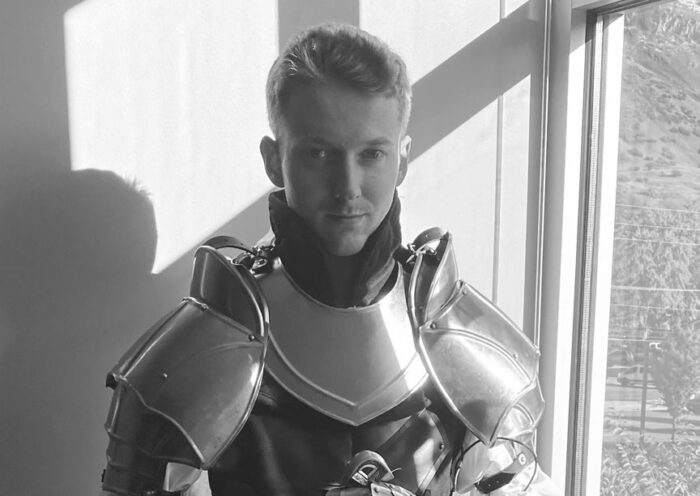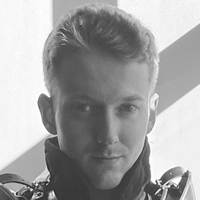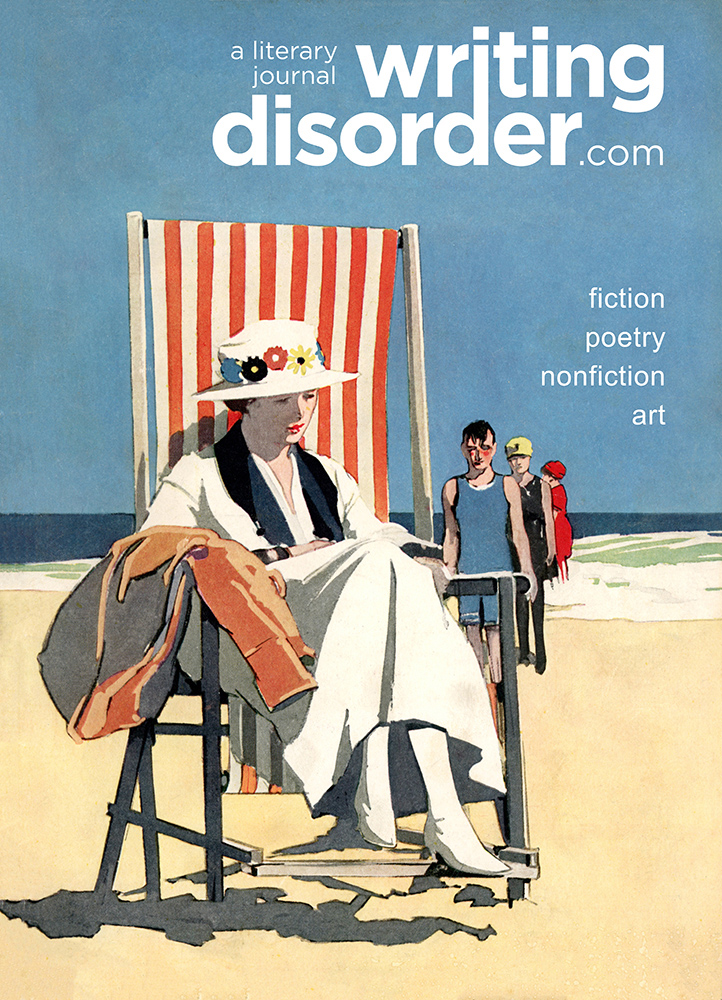I Am Autism
by Jonathan Kruyer
Weird. Strange. Quiet. Disruptive. Sensitive. Emotionless. Gifted. Special. Under-developed. Special needs. An old soul. Childish. Star seeds. Aspergers. So many ways to avoid calling someone autistic. Parents would rather say that their child is “sensitive” or “quiet” than admit that their child is autistic. Teachers would rather say that their student is “gifted” or “special needs” than admit that their student is autistic. Children and adults alike would rather say that their peer is “weird” or “strange” than admit that their peer is autistic.
Growing up, my parents always said they didn’t “believe in labels.” If I struggled I just had to “suck it up” (their other favorite thing to say) and work harder. The possibility that I might be autistic was never even discussed. My parents refused to imagine there could be anything “wrong” with me, and to them, admitting I was autistic would be exactly that. What they failed to realize is that avoiding a diagnosis did nothing to keep me from getting labeled. It just meant I had many different labels. In school, if a class aligned with my special interests I was labeled “gifted,” and if a class did not align with my special interests I was labeled “distracted” and “not living up to my potential.” These labels were used by educators to put the responsibility for my development on me, rather than taking the effort to try to figure out my needs and accommodate them. Among other kids, I was labeled “weird,” “nerdy,” and even in some cases “freak.” These labels were used to exclude and divide, limiting my socialization to others who had been similarly rejected. Following my parents’ advice to simply work harder and “suck it up” led to me first experiencing a condition known as autistic burnout in senior year of high school, and I was then labeled “lazy” because I simply did not have the energy to work anymore. My parents refusing to admit I was autistic didn’t help me at all. It just meant the labels I received tore me down and offered no answers on how I could climb back up.
A recent study has shown that people who aren’t autistic (the scientific term for that is allistic) unconsciously identify an autistic individual within the first minute of meeting them and “are less willing to interact with those with autism based on thin slice judgments.” The study found that allistics consistently determined that they disliked autistics after only seconds of interaction and that they were routinely uneasy and even repulsed while interacting with autistics. Allistics usually cannot properly define what it is they are recognizing and disliking, but it happens nonetheless. They see someone sitting in a strange way or twiddling their fingers in the air, they notice as the person they are speaking with cannot meet their eyes or stares into their eyes a little too directly, they hear someone speak in a monotone voice or get too loud and animated as they speak about something they are interested in, and they unconsciously mark that individual as “different.” As wrong. In other words, autistic people give allistic people the “uncanny valley” effect.
The “uncanny valley” is a translation of Japanese bukimi no tani, coined by the roboticist Masahiro Mori, who created a graph that plotted the emotional response of a human being to a robot against the increase in the perceived realism of a robot; the graph showed a significant dip at the point where the robot’s resemblance to a human is perceived to be almost exact. Oxford defines the uncanny valley as “the phenomenon whereby a computer-generated figure or humanoid robot bearing a near-identical resemblance to a human being arouses a sense of unease or revulsion in the person viewing it.” It is the feeling that something is off, that what you are looking at isn’t quite right. This is the same reaction allistics have to autistics. To the allistic mind, autistics are in the same category as robots and computer-generated figures, able to mimic humanity, but unable to fully replicate what it means to be human. On a subconscious level, allistics instinctively view autistics as not human.
If you are allistic, you may be reading this right now thinking “I don’t think that way. I don’t view autistic people as not human,” and I would bet you genuinely believe that. And on a conscious level, you are probably right. But if you were to really pay attention to your first gut reaction when you encounter “weird” or “unsettling” people, you would see it. You likely don’t even realize they are autistic when you have this reaction. You just know they are strange, they are different. And, in your first gut reaction, you instinctively know they are wrong.
I see this reaction often. I can’t meet someone’s eyes for more than a moment, I sit strangely with my legs in a tangle at level with my head, I talk too animatedly about one of my special interests, I twiddle my fingers in the air to give them something to do while I try to listen to someone else speak, I flap my hands in excitement or anxiety, and I see it. The “what a freak” look. The look that shows this individual has categorized me as weird or wrong or crazy. I have stopped caring about this, mostly. But that doesn’t mean I don’t notice. And I know I don’t get the worst of it by far. There are many whose autistic traits are more visible than mine who can’t have a single interaction without that “freak” label slapped onto them.But of course you would never think that way about autistic people. You wouldn’t be that mean.
And that’s what it inevitably wraps back to. Autism is an official diagnosis of a mental disability, and no one likes to think the reason they dislike someone is because they are bigoted and biased against someone with a disability. So they think that person cannot possibly be autistic. They are weird, or strange, or creepy, but not autistic. The weird person is the problem, not you. The problem could not possibly be you. Because you are the normal one. They are the one being weird.
Nearly everyone who has heard the word “autistic” has a predetermined idea in their head of what “autistic” looks like. Maybe it’s your aunt’s autistic nonverbal son, who needs help to eat. Maybe it’s a kid who goes to your church who will recite the entire script of their favorite movies to whoever will listen. Maybe it’s an “autistic savant” who cannot deal with social situations without breaking down but perfected their skill at mathematics or piano playing or something else when they were eight. Maybe it’s a character from a tv show you’ve watched, like Sheldon Cooper from the Big Bang Theory. Whatever your mental image, it is inevitable that what you imagine to be autism is, at best, only a small sliver of the autistic experience, seen from outside.
Autism is not just one thing. All autistics have certain similar traits as a result of our unique brain structure that connect us, but how that looks on the outside varies widely, with results across a wide spectrum. When you hear “spectrum,” you might imagine a line, with one end being “less autistic” and another end being “more autistic.” This is incorrect. It is true that some people “seem” more autistic than others, but this seeming is a result of outside perspective. The autism spectrum is not a line. It is more like a color wheel. How autism looks and is expressed will vary as much from one autistic to another as red does from blue or yellow, but they are all equally autistic. There is no such thing as “more” or “less” autistic. The nonverbal autistic is not more autistic than a hyper verbal autistic, and an autistic who is able to mask well enough to pass themselves off as allistic when they need to is not less autistic than an autistic who is incapable of masking. While they might not necessarily fit what you have been taught to picture as autistic, all of these are equally autistic.
So far too often, the person you think is weird and unsettling is still somehow too “normal” to be autistic, because they don’t act or look like how you have decided autism acts or looks like. When an autistic person has a meltdown, they are just being dramatic or childish and need to get over it. When an autistic person is experiencing shutdown, they are creepy and emotionless. When an autistic person begins infodumping, they are full of themselves and just like to hear the sound of their own voice, or they are getting too agitated about something that doesn’t matter and they need to calm down. When they deal with executive dysfunction, they are lazy or not applying themselves. When they can’t meet your eyes, they are shifty or lying. When they fail to understand social cues and social norms, they are being difficult and not respecting authority. Everyone else understands how these things work. Everyone else gets it. Everyone else has “common sense.” So why don’t they? They must be the problem. And despite the fact that everything I listed is literally diagnostic criteria for autism, the problem could not possibly be that they are autistic. Because that would mean you are the asshole. And that can’t possibly be the case.
It’s not your fault, not really. If you’re allistic, then the world we live in was designed for your neurotype. Everyone is expected to play by the unspoken rules of a game you understand intrinsically. The fact that the rules never get explained aren’t your fault. It is no surprise that when looking at someone who thinks so differently from you, at someone who obviously does not fit in this world in the way you do, that you would instinctively see them as something that doesn’t belong. Because we don’t. But that’s because people whose brains work like yours designed this world in a way that ensures we can never truly belong.
Now this is not to say you have no issues or that the world was perfectly made so that you would never struggle with it. That would be ridiculous. Everyone has struggles. But if you are allistic, then this society is structured for you, because it was structured and continues to be run by allistic people. You are in the majority, so it makes sense for everything to be built around the way your brain works. The fact that millions of autistic people are being continuously torn apart by the constant requirement to live up to allistic standards doesn’t factor into it, because it’s a problem you never see.
Can you imagine living in a world where you are constantly punished just for thinking? Where the way your brain works is a crime, and you have to pretend to think in a completely different way if you want to continue existing in society? Where accidentally revealing the way you think, from a misplaced word or making the wrong facial expression, results in ostracization and incrimination? That is only a fraction of the struggle of being autistic in an allistic world. This may sound like an exaggeration, but I can promise it is not.
Imagine with me for a moment that you have moved to a foreign country. You speak the language well enough, but you learned the language almost entirely from reading textbooks. You know the literal meaning of the words the people around you say, but you understand none of the slang, none of the euphemisms, none of the colloquialisms, none of the little nuances of culture and tradition. You don’t know any of the social rules of this society, and every time you try to ask and learn these rules you are met with scorn and disbelief. “You should already know this,” they say, and refuse to answer your questions. This happens enough times that you begin to wonder if they even understand the rules themselves, or if they are just making it all up as they go along and using your ignorance of this fact to mess with you. Sometimes, when you think you have figured out one of the rules of this strange culture, it seems to suddenly change, and once again everyone looks down on you. “That only applies in specific situations,” they tell you. You ask what situations it applies to and which it doesn’t, and they laugh and reply “you just have to be able to tell.” But you can’t. You can’t figure out which situations the rule applies to and which they don’t. People start to assume that you are doing this on purpose, that you are deliberately breaking the rules of their society just to be rude. After all, you should have figured it out by now.
What I have just described is a mere fraction of my daily experience. I live with this reality every day of my life. And it is only the beginning.
Have you ever heard of ABA therapy? Applied Behavior Analysis or ABA therapy, is a “therapy” method used on autistic children, and is defined by Autism Speaks (a hate group that likes to pretend it is trying to “help” autistics) as “a therapy based on the science of learning and behavior,” that “applies our understanding of how behavior works to real situations. The goal is to increase behaviors that are helpful and decrease behaviors that are harmful or affect learning.” The intent of ABA therapy is to “Increase language and communication skills,” “Improve attention, focus, social skills, memory, and academics,” and “Decrease problem behaviors.” Sounds great, right? Sure, to an allistic person, especially the allistic parent of an autistic child. But can you guess what the “problem behaviors” and “behaviors that are harmful” are? They are autistic behaviors. They are behaviors like infodumping, in which an autistic shares large amounts of information about one of their special interests. They are behaviors like stimming, which is necessary for proper emotional regulation in autistics. They are behaviors that, while they might occasionally make allistics uncomfortable, do no real harm, and are in fact integral for autistics to live happy, healthy lives.
While groups like Autism Speaks use flowery language to hide it, ABA therapy’s purpose is to coerce and force autistic children to stop acting autistic and to act more allistic. To hide who they are or be punished. This is one of the most commonly used “therapy” methods for autistic children, and is the cause of immense trauma for countless autistic people as they grow up, as they are unable to properly express themselves, trapped by the abusive training stamped into them from childhood.
Autism Speaks is the biggest and most public “advocacy group” for autistics in the world. But if you ask nearly any actual autistic person what they think of Autism Speaks, they will not have a single kind word to say about it. Why? Because Autism Speaks is not an advocacy group. It is a hate group. Autism Speaks supports ABA therapy, but that is only the beginning. Autism Speaks once put out an ad titled “I am Autism,” in which autism is characterized as an insidious, amoral force that infiltrates families and seeks to destroy them, autistic children are presented as burdens on their parents that cause only problems, and parents are encouraged to “fight” and “beat” autism. Autism Speaks’s original mission statement stated: “We are dedicated to funding global biomedical research into the causes, prevention, treatments and a possible cure for autism.” A cure. Autism is not a disease. There can be no cure, and I would not want a cure even if there was one.
I love being autistic. I don’t love how I am treated because of it or how much I suffer trying to work in a world that does not accommodate my needs, but I love being autistic nonetheless. It is because of my autism that I am who I am. It is because I am autistic that I get completely lost in fantastical worlds and learn everything there is to know about them, from history to geography to technology to all the important characters and their own personal histories and character quirks. It is because I am autistic that when I get truly excited I physically cannot contain it and all that emotion needs to escape in the form of stimming. It is because I am autistic that I can remember countless little details about the things I love. It is because I am autistic that my brain is constantly flooded with new ideas for stories and worlds and characters for me to build and explore and get to know. Everything I love about myself is because I am autistic. But people like Autism Speaks see all this and only see a problem that needs to be solved. A puzzle piece that needs to be forced to fit into their perfect puzzle. A broken thing to be fixed.
These are the sort of things autistic people are forced to deal with their entire lives. We are expected to hide who we are, to pretend we think like everyone else, to play the allistic guessing game and ignore our needs in order to make everyone else feel comfortable. And all that work doesn’t even succeed at convincing people that we are normal. No matter how much an autistic person works to hide that they are autistic, no matter how well they “mask,” allistics still have that same gut reaction when they meet us. We still trigger the uncanny valley effect, the internal warning in your mind that tells you that something is off about us, that we aren’t quite “human.” Because for some reason, “human” only includes those who think and act like you.
To be honest with you, even now I have barely scratched the surface of the autistic struggle. I have barely even mentioned autistic burnout, how the constant pressure to mask and live up to allistic standards of personhood inevitably results in anxiety, depression, and an inability to perform even basic tasks that were once simple or easy. I have not talked about how the average life expectancy for autistic people is 36, due in large part (among other factors) to high rates of suicide. I have not talked about how autistic people are regularly used as tools by hate groups like transphobes who claim autistic children are being “tricked” into transitioning, because these hate groups think we can’t speak for ourselves and are thus easy tools for garnering sympathy. I have not talked about how the now-defunct diagnosis of aspergers has its origins in Nazi race science as part of how to determine which autistic people should be allowed to live. I have not talked about how autism is regularly used as an excuse for eugenics, as people consistently speak about how they want a genocide of autistic people through use of a “cure” or finding a way to identify and then abort all autistic fetuses. I have not talked about how certain countries don’t allow autistic immigrants because they believe they will be too much of a burden on the nation. I have not talked about how anti-vaxxers treat having an autistic child as worse than a dead one, because they refuse to give their children life saving vaccines due to their fear that the vaccine will give their child autism. I have not talked about how autistic behaviors and traits are regularly used in media to characterize “inhuman” characters like aliens and robots. I have barely touched upon the myriad of issues that face autistic people on a daily basis and the countless ways we are dehumanized in all aspects of life.
There is so much I could talk about, so many injustices I could address, so many casual hate crimes committed against us without a second thought, so many ways the society we live in was built in a way that actively works to tear down autistic people. And maybe one day I will talk about it all, though I think I would need a lot more than just an essay to explain it all. It would require a full book, at the very least. So for now, I will leave you with something smaller.
I am autistic. Maybe I match your mental image of what autism is. Maybe I don’t. But I am far from the only autistic person you have interacted with in some way. Early in 2023, the CDC reported that 1 in every 36 children is diagnosed with autism. And that is without even considering how often autism goes undiagnosed, due to sexism, racism, and myriad other factors. This means that at the very minimum, there are considerably more autistic people in the world than there are redheads (as about 1-2% of the world’s population has red hair). Think about how many redheads you have encountered. You have encountered many more autistic people than you have redheads. Or, to use an example with less geographical variation, simply think about how many people in general you have met. Over the course of your life, you have likely interacted with thousands of people, which means you have likely interacted with at least dozens of autistic people, if not hundreds.
So the next time you get that gut reaction, the next time you look at someone acting in a way that doesn’t make sense to you, the next time you look at someone and think “they’re weird” or something similar, the next time someone freaks out about something you think is trivial, the next time someone has difficulty doing a task you think is simple or easy, the next time someone fails to understand something you think should be obvious, the next time someone can’t meet your eyes or acts disrespectfully or does any number of things that seem wrong to you, remember what I have said. And think about it. And maybe, just maybe, try to be a little kinder.
BIO
Jonathan Kruyer is a Canadian-American writer and author with a Bachelor of English from Brigham Young University. While his true joy is writing fantasy, this essay was born from his experiences living as an autistic person in an allistic world and the struggles that come from having a brain that works differently from those of everyone around you. You may reach him at jonathankruyer@gmail.com or check out his narrative ttrpg podcast, The Genesys Archives.



















